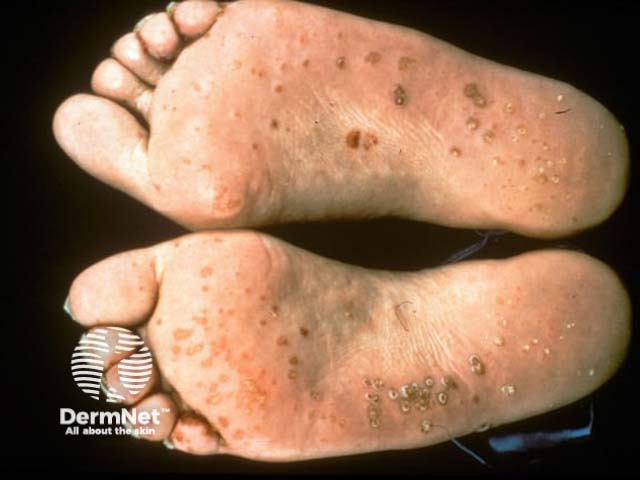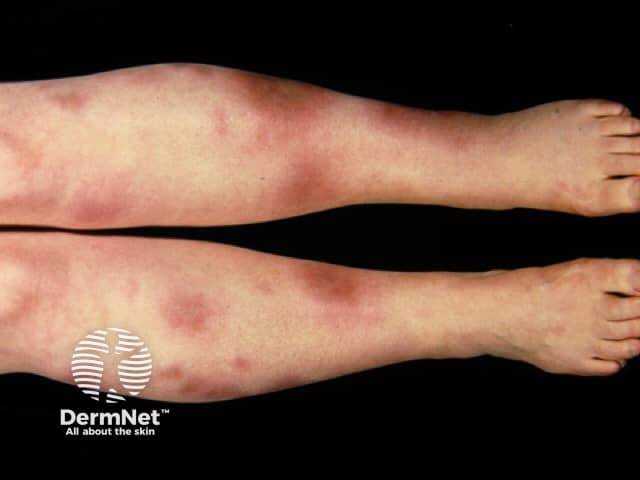Main menu
Common skin conditions

NEWS
Join DermNet PRO
Read more
Quick links
Reactive arthropathy — extra information
Reactive arthropathy
Author: Dr Amy Choi, Medical Registrar, Waikato Hospital, Hamilton, New Zealand. DermNet Editor in Chief: Adjunct A/Prof Amanda Oakley, Dermatologist, Hamilton, New Zealand. Copy edited by Gus Mitchell. January 2020.
Introduction Demographics Causes Clinical features Diagnosis Differential diagnoses Treatment Outcome
What is reactive arthropathy?
Reactive arthropathy describes the inflammation of joints following an infection usually involving the gastrointestinal or urogenital tracts [1–3]. Symptoms of arthritis typically begin a few weeks after the initial infection and may persist for several months to a year. Microorganisms cannot be cultured from the joints in reactive arthropathy as the infection occurs elsewhere in the body, distinguishing this from septic arthritis [3].
Reactive arthropathy is also known as reactive arthritis. The triad of reactive arthropathy associated with inflammation of the bladder outflow tract (urethritis) and the eyes (conjunctivitis) was formerly termed Reiter disease or Reiter syndrome [2] and is commonly associated with mucocutaneous changes.
Reactive arthropathy may also be associated with skin changes and lesions of the mucous membranes [3].
Who gets reactive arthropathy?
Reactive arthropathy affects both men and women and is seen most commonly in young adults between the ages of 20 and 40 years [1].
- Higher rates of reactive arthropathy are seen in males compared with females following a urogenital or upper respiratory tract infection.
- Reactive arthropathy is equally common in males and females following an enteric foodborne infection [3].
In the Caucasian population, HLA-B27 antigen and HIV/AIDS are strongly associated with reactive arthropathy [1,3,4].
What causes reactive arthropathy?
Reactive arthropathy is triggered by an infection of the urogenital or gastrointestinal tracts. Cross-reactivity of the immune system between infectious antigens and self-proteins is thought to result in an autoimmune response [3].
Typical pathogens affecting the gastrointestinal tract include:
- Salmonella
- Shigella
- Yersinia
- Campylobacter
- Clostridium (Clostridioides) difficile.
Pathogens affecting the genitourinary tract include:
- Chlamydia trachomatis and Chlamydia pneumoniae
- Escherichia coli
- Ureaplasma urealyticum
- Mycoplasma genitalium [1,3,5].
The underlying infection may be asymptomatic, particularly in women.
The inability to culture a typical pathogen does not exclude the diagnosis of reactive arthropathy. In up to 40% of patients, no infectious organism is found [2].
What are the clinical features of reactive arthropathy?
Patients may report symptoms of a recent systemic infection, particularly involving the genitourinary or gastrointestinal tract. These typically precede musculoskeletal symptoms by several days to a few weeks and include:
- Fever
- Diarrhoea
- Pain passing urine (dysuria) or increased urinary frequency due to inflammation of the bladder (cystitis) or bladder outflow tract (urethritis)
- Pus or discharge from the penis or vagina
- Lower abdominal pain [1,3,5].
Clinical features of the reactive arthropathy are similar regardless of the precipitating infection.
- Symptoms begin with the sudden onset of pain and swelling of several joints.
- It is usually an oligoarthritis (involving fewer than five joints).
- Reactive arthritis has an asymmetrical distribution, frequently involving the lower limbs and knees.
- Fingers and toes may become swollen and sausage-shaped (dactylitis).
- Pain and swelling may affect the sites of tendon and ligament insertion, particularly on the heels and feet (enthesitis)
- Back pain and morning stiffness may occur (sacroiliitis) [1–3,5].
Common ocular symptoms include pain, redness and irritation of the eyes (conjunctivitis). In some cases, uveitis and iritis may occur, causing blurred vision, light sensitivity and headaches [1,3].
Cardiac symptoms include heart valve abnormalities and abnormal electrical activity. Kidney and central nervous system involvement are rare [3].
Cutaneous features of reactive arthritis
Skin involvement develops some months after the onset of arthritis. Cutaneous signs include:
- Painless mouth ulcers
- Tender, thickened skin and scaly patches involving the soles of the feet and lower legs (keratoderma blenorrhagicum)
- Erythematous genital lesions and shallow ulcers affecting the glans penis (circinate balanitis)
- Erythema nodosum [1,3]
- Nail changes including nail thickening and onycholysis.


Reiter syndrome

Erythema nodosum
How is reactive arthropathy diagnosed?
A diagnosis of reactive arthropathy is based on the pattern of symptoms and signs. Although there are no specific tests to confirm the diagnosis of reactive arthropathy, it may be suspected when the following key features are present and other causes for the symptoms have been excluded [1]:
- A history of a preceding infection
- Typical musculoskeletal symptoms such as arthritis, dactylitis, sacroiliitis, and enthesitis.
Samples of fluid may be taken from swollen joints using a needle (arthrocentesis) to culture for the presence of microorganisms (found in septic arthritis) or to examine under microscopy for crystals (found in gout or pseudogout) [5].
Plain film x-rays may be performed to rule out other causes for joint pain [1]. Ultrasound scans and magnetic resonance imaging (MRI) may be useful to demonstrate musculoskeletal inflammation [5].
HLA-B27 and HIV testing are recommended.
What is the differential diagnosis for reactive arthropathy?
The diagnosis of reactive arthropathy requires that other causes of joint pain and swelling are excluded. This includes both infective and inflammatory processes.
- Crystal arthropathy (gout) — monosodium urate or calcium pyrophosphate crystals are present in joint fluid. Crystal arthropathy usually affects a single joint (monoarthritis).
- Septic arthritis — inflammatory cells and microorganisms are present in joint fluid.
- Lyme disease
- Arthritis associated with inflammatory bowel disease (Crohn disease or ulcerative colitis)
- Behcet syndrome
- Psoriatic arthritis
- Another spondyloarthropathy
- Post-streptococcal arthritis [5].
What is the treatment for reactive arthropathy?
Treatment of precipitating infection
Antibiotics should be initiated to reduce the risk of progression or complications from the initial infection. This is particularly important for genitourinary infections such as chlamydia [2]. Antibiotics have not been shown to affect the outcome of the reactive arthropathy [5].
Treatment of reactive arthropathy
Pain, joint swelling, and reduced mobility are treated with:
- Nonsteroidal anti-inflammatory drugs (NSAIDs) such as naproxen, diclofenac, and ibuprofen
- Steroid injections into the joint space [1]
- Systemic steroids (eg, prednisone) in low to moderate doses [5]
- Systemic disease-modifying anti-rheumatic drugs (DMARDs) such as sulfasalazine and methotrexate [1,5]
- Anti-TNF medications such as infliximab (off-label) [1,2,5].
While these treatments may provide relief from the symptoms of reactive arthropathy they do not shorten the duration of disease. DMARDs are often introduced for persistent symptoms lasting more than 3–6 months to avoid the side effects of long-term prednisone.
Treatment of associated symptoms
Patients with suspected eye involvement should be assessed by an ophthalmologist for further management.
Treatment of the cutaneous disease associated with reactive arthropathy is like the treatment of psoriasis.
- Topical therapy may include topical steroids, coal tar products, and calcipotriol, or combinations of these (eg, calcipotriol/betamethasone dipropionate)
- Phototherapy
- Methotrexate
- Biologic agents [5].
What is the outcome for reactive arthropathy?
Reactive arthropathy is usually a self-limited condition and carries a good prognosis. Symptoms typically persist for several months then resolve completely. A few people develop chronic arthritis with ongoing symptoms for longer than one year. These patients are more likely to be HLA-B27 positive [2,5].
References
- Garcia-Kutzbach A, Chacon-Suchite J, Garcia-Ferrer H, Iraheta I. Reactive arthritis: update 2018. Clin Rheumatol. 2018 Apr;37(4):869-874. doi: 10.1007/s10067-018-4022-5. Epub 2018 Feb 17. PMID: 29455267. PubMed
- Duba AS, Matthew SD. The seronegative spondyloarthropathies. Prim Care. 2018 Jun;45(2):271-287. doi: 10.1016/j.pop.2018.02.005. PMID: 29759124. PubMed
- Stravropoulos PG, Soura E, Kanelleas A, Katsambas A, Antoniou C. Reactive arthritis. J Eur Acad Dermatol Venereol. 2015 Mar;29(3):415-24. doi: 10.1111/jdv.12741. Epub 2014 Sep 8. PMID: 25199646. PubMed
- Lozada, CJ. Reactive Arthritis. Medscape. Updated 6 December 2018. Available at: emedicine.medscape.com/article/331347-overview (accessed 9 December 2019).
- David DT, van Tubergen A. Reactive arthritis. UpToDate. Updated 31 May 2018. Available at: www.uptodate.com/contents/reactive-arthritis (accessed 30 May 2018).
On DermNet
- Psoriasis
- Psoriatic arthritis
- Spondyloarthropathy
- Psoriasis of the soles and hands
- Cracked heel
- Foot skin conditions
- Hand skin conditions
